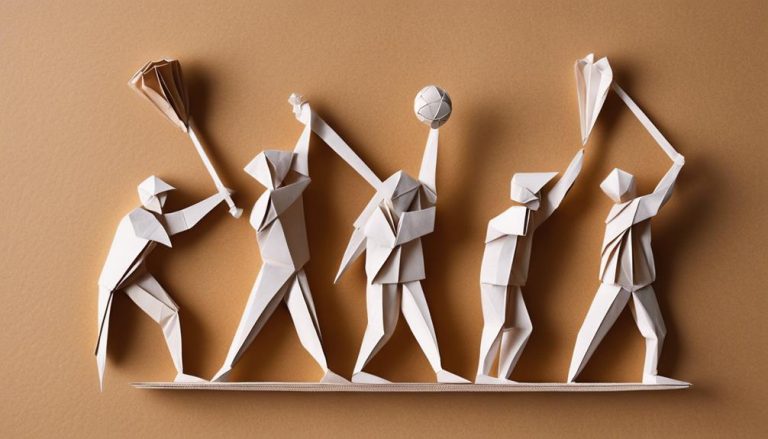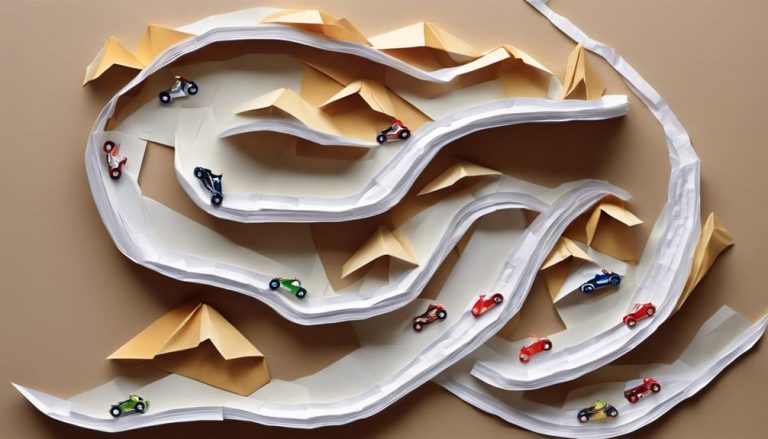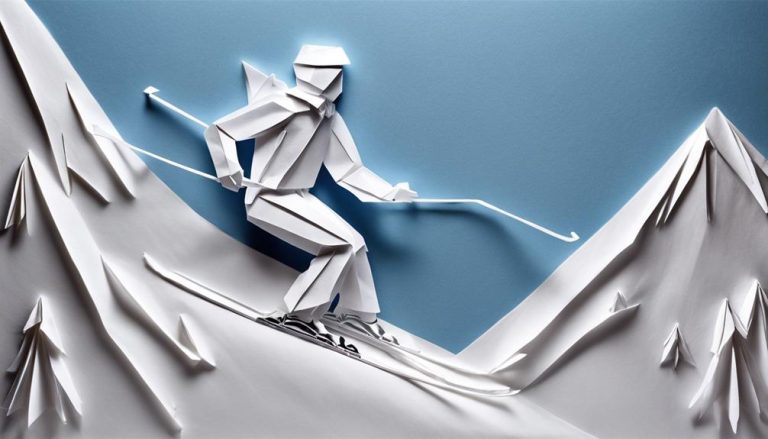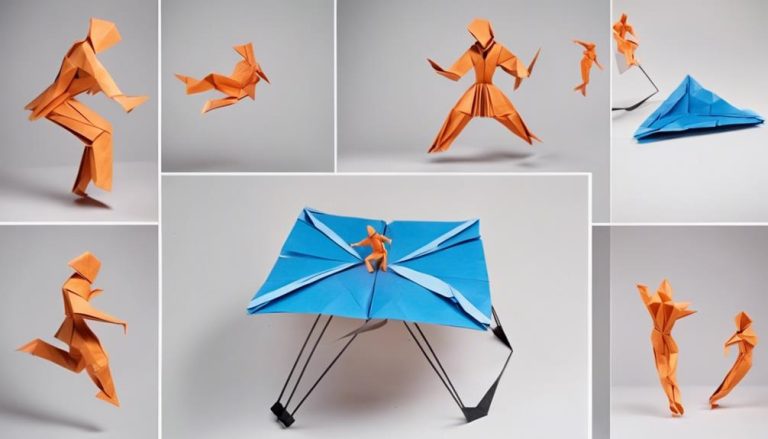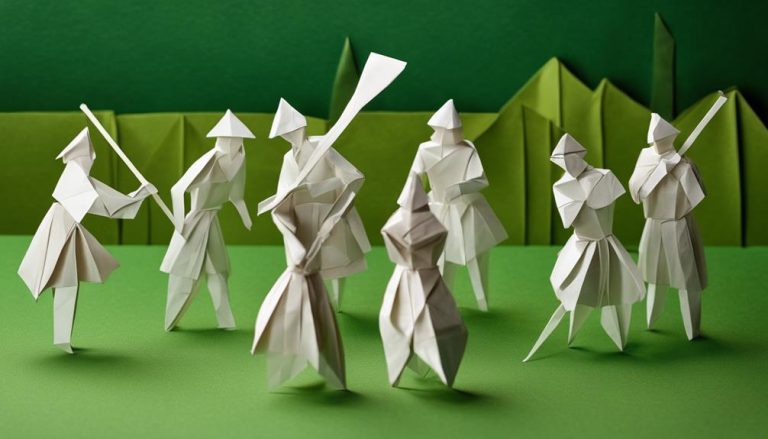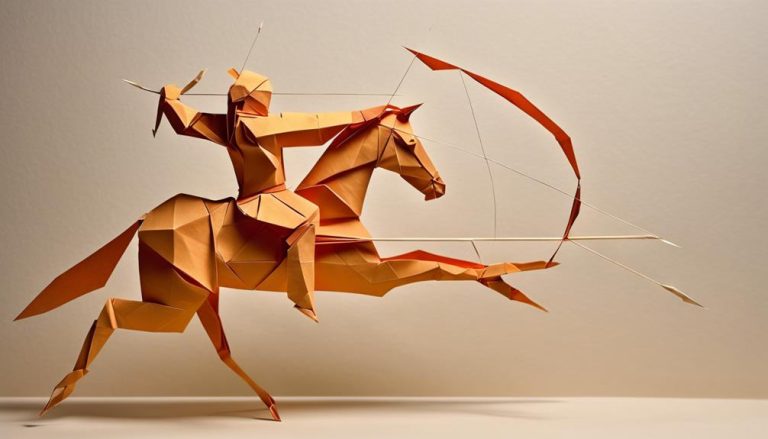General Rules of Skateboarding
Did you know that skateboarding is one of the top five most popular sports globally, with over 11 million participants? When it comes to mastering the art of skateboarding, there are essential rules and techniques that every skater should adhere to. From the proper use of safety gear to understanding skatepark etiquette, each aspect plays a crucial role in enhancing your skills and ensuring a safe ride. By familiarizing yourself with these general rules, you can elevate your skateboarding experience and progress to new levels of proficiency.
Safety Gear

When gearing up for a skateboarding session, it is absolutely essential to prioritize safety by wearing the proper protective gear. Your helmet safety is non-negotiable; it's your shield against potential head injuries. Make sure it fits snugly and meets safety standards. Knee pads are your best friends, cushioning your falls and protecting your knees from scrapes and bruises. Wrist guards are a must-have, especially for beginners; they shield your wrists from sprains and fractures. Elbow pads are often overlooked, but they are crucial for preventing painful elbow injuries.
Skateboarding liberates you, but that freedom should never come at the cost of your safety. Embrace the protective gear not as a hindrance, but as a shield that allows you to push your limits without fear. Your gear empowers you to try new tricks, explore challenging terrain, and skate with confidence. Respect your body and your craft by investing in quality safety gear – it's the foundation of your skateboarding journey.
Skatepark Etiquette
Prioritize respect and consideration for others in the skatepark by mastering the unspoken rules of Skatepark Etiquette. When you step into a skatepark, you enter a community where mutual respect is paramount. Skatepark etiquette is the glue that holds this vibrant culture together. Whether you're a seasoned skater or just starting, understanding and following these unwritten rules is crucial.
In skate competitions, proper etiquette can make or break your experience. Always wait your turn, and don't hog the obstacles. Respect the flow of the park and be mindful of other skaters around you. Communicate with fellow skaters to avoid collisions and maintain a safe environment for everyone.
Skateboarding culture thrives on inclusivity and camaraderie. Embrace this spirit by cheering on others, offering help, and sharing the stoke. Remember, the skatepark is a space for everyone to enjoy, so treat it with care and consideration. By embodying skatepark etiquette, you contribute to a positive and welcoming community that celebrates the freedom and creativity of skateboarding.
Riding Stance

Ready to elevate your skateboarding skills to the next level? Let's delve into the crucial aspect of Riding Stance. Your stance adjustments and riding transitions are fundamental in mastering skateboarding. Achieving the perfect balance through proper weight distribution is key to unlocking your full potential on the board.
When it comes to riding stance, understanding turning techniques is essential. Whether you prefer a regular or goofy stance, knowing how to shift your weight effectively will significantly impact your performance. Experiment with different stances to find what feels most natural and allows you to maneuver with ease.
As you ride, pay attention to how your body moves with each turn. Practice smooth transitions from heel to toe to execute sharp turns and fluid movements. Your stance on the board influences your control and stability, so be mindful of your positioning as you navigate different terrains. Embrace the freedom that comes with mastering your riding stance, and watch as your skateboarding skills soar to new heights.
Foot Positioning
Alright, so let's talk foot positioning. When you're out there shredding, your stance basics, balance and control, and nailing those tricks and maneuvers all come down to how you position those feet on the board. Get ready to fine-tune your footwork for maximum performance and style on the streets or at the park.
Stance Basics
Positioning your feet correctly on the skateboard is fundamental to mastering your stance basics in skateboarding. Stance alignment and weight distribution are crucial for maintaining balance and control. Your front foot angles and back foot positioning play a significant role in how you maneuver your board and perform tricks. To ensure you have a solid foundation, follow these guidelines:
| Stance Alignment | Weight Distribution | Front Foot Angles | Back Foot Positioning |
|---|---|---|---|
| Parallel to the board | Equal distribution between both feet | Slightly angled towards the nose | Near the tail with toes hanging off |
Balance and Control
To achieve optimal balance and control on your skateboard, ensure your foot positioning is precise and deliberate. Your weight distribution plays a crucial role in maintaining stability and maneuvering smoothly. Here are three key points to consider when positioning your feet:
- Front Foot Placement: Place your front foot just behind the bolts of the skateboard to maintain control over the board's nose.
- Back Foot Positioning: Keep your back foot on the tail of the skateboard to help with pop and turning movements, ensuring your center of gravity is balanced.
- Equal Weight Distribution: Distribute your weight evenly between both feet to stabilize your body and maintain control over the board, enhancing your overall skateboarding experience.
Tricks and Maneuvers
When attempting tricks and maneuvers on your skateboard, mastering the art of foot positioning is key to executing moves with precision and style. Proper foot placement can make all the difference in nailing those flip tricks and aerial maneuvers flawlessly. For flip tricks, positioning your front foot just behind the front bolts and your back foot on the tail provides the ideal balance for popping and flicking the board. When it comes to aerial maneuvers, having your feet centered and ready to adjust for stability mid-air is crucial. For manuals and stalls, shifting your weight and adjusting your feet accordingly will help you maintain control and balance. Check out the table below for a quick guide on foot positioning:
| Trick Type | Front Foot Position | Back Foot Position |
|---|---|---|
| Flip Tricks | Behind front bolts | On the tail |
| Aerial Maneuvers | Centered | Ready to adjust |
| Manuals | Centered | Near the tail |
| Stalls | Centered | Slightly off center |
Pushing Techniques
Alright, let's talk about pushing techniques. When you skate, remember the importance of proper foot placement and balancing while pushing. These techniques are fundamental for maintaining speed and control on your board.
Proper Foot Placement
Ensuring proper foot placement while skateboarding is fundamental to mastering efficient and powerful pushing techniques. Here are key elements to consider:
- Weight Distribution: Keep your weight evenly distributed between both feet to maintain balance and stability while pushing.
- Foot Archetypes: Pay attention to your foot archetypes, whether you have a neutral, high, or flat arch, as this can influence how you push off the ground effectively.
- Pushing Techniques: Experiment with different foot angles and positions to find what works best for you, allowing for smooth and powerful pushes that propel you forward effortlessly.
Mastering foot placement is the cornerstone of a solid pushing technique, leading to a more enjoyable and liberating skateboarding experience.
Balancing While Pushing
To maintain balance and fluidity while pushing on a skateboard, focus on syncing your movements with the board's momentum. Proper weight distribution is key; lean slightly forward to control speed and prevent the board from shooting out behind you. Adjust your posture by keeping your knees slightly bent and your back straight, allowing for better control and stability. By managing your momentum effectively, you can push off the ground smoothly without losing balance. Remember, pushing techniques are not just about propulsion but also about maintaining control. Mastering the art of balancing while pushing will elevate your skateboarding experience, giving you the freedom to cruise effortlessly. So, hone your skills in weight distribution, speed control, posture adjustment, and momentum management to ride with confidence and ease.
Turning Basics

When mastering turning basics in skateboarding, focus on shifting your weight and using your body to guide the board smoothly through the turn. Embrace the exhilaration of leaning into each curve, feeling the wind rush against your skin as you effortlessly navigate the concrete waves. Here's your guide to turning like a pro:
- Turning Techniques: Experiment with different turning methods, from sharp kick turns to fluid carving motions. Find your style and let it flow naturally as you glide along the pavement.
- Body Positioning: Keep your knees bent and your body centered over the board. Engage your core muscles to maintain balance and control, allowing you to execute turns with precision and grace.
- Weight Distribution: Shift your weight towards the direction you want to turn. By distributing your weight effectively, you can initiate and complete turns smoothly, maintaining speed and stability throughout the maneuver.
Unlock the freedom of movement that skateboarding offers, and let the art of turning become second nature as you conquer the streets with finesse and style.
Braking Methods
As you continue to refine your skateboarding skills, mastering various braking methods is crucial for maintaining control and safety on the streets. When it comes to stopping on a skateboard, there are essential techniques to learn that will not only help you stay safe but also add flair to your riding. Sliding techniques are a popular choice for advanced riders, allowing for quick and controlled stops. By shifting your weight and using your shoes to slide against the ground, you can come to a smooth halt even at higher speeds. Understanding proper foot positioning is key in executing these slides effectively.
Speed control is another vital aspect of braking. By adjusting your body posture and leaning back slightly, you can decrease your speed gradually. This method is particularly useful when cruising downhill or approaching obstacles. Remember, mastering these braking methods will not only enhance your skills but also give you the confidence to tackle new challenges on your skateboard.
Ollie Fundamentals

Alright, ready to master the art of the Ollie? Let's talk about the crucial points: Ollie Foot Positioning, Timing and Pop, and the Front Foot Slide. Nail these fundamentals, and you'll be soaring over obstacles in no time. Let's break it down step by step and get you shredding like a pro!
Ollie Foot Positioning
Positioning your feet correctly is crucial for mastering the ollie, a fundamental trick in skateboarding. When it comes to ollie foot positioning, make sure your front foot is just behind the front bolts and angled slightly towards the nose of the skateboard. Your back foot should be on the tail, ready to pop. Here's a quick guide to help you nail your ollies:
- Front Foot: Place it just behind the front bolts with toes angled towards the nose.
- Back Foot: Position it on the tail, ready to pop the board.
- Slide Technique: Practice sliding your front foot up towards the nose as you pop to level out the board.
Mastering proper ollie foot positioning is key to unlocking a world of skateboarding possibilities.
Timing and Pop
Nailing the timing and pop is essential for taking your ollies to the next level in skateboarding. Timing tips are crucial – you want to pop the tail of your board down right as you slide your front foot up the board. This coordinated effort creates the ollie's iconic lift. Remember, the quicker you pop, the higher you'll go. For pop tricks, focus on mastering the pop timing. Practice popping the tail hard and fast, ensuring your board reacts with a crisp snap. As you progress, experiment with different timing variations to add style and flair to your ollies. So, keep pushing your limits, perfecting your pop, and watch your trick progression soar to new heights!
Front Foot Slide
Mastering the front foot slide is a critical fundamental skill in skateboarding, essential for perfecting your ollies and advancing your trick repertoire. To excel in this technique, focus on the following:
- Front foot positioning: Place your front foot just behind the front bolts of the skateboard, angled slightly towards the nose for better control.
- Slide technique: As you pop the tail and slide your front foot up towards the nose, ensure it glides smoothly and consistently to level out the board.
- Balance control, Foot placement: Maintain balance by keeping your weight centered and distributing pressure evenly between both feet. The precision of your foot placement will dictate the height and levelness of your ollies. Mastering the front foot slide will elevate your skateboarding prowess and unlock a world of possibilities on the streets and at the skatepark.
Ramp Riding Tips
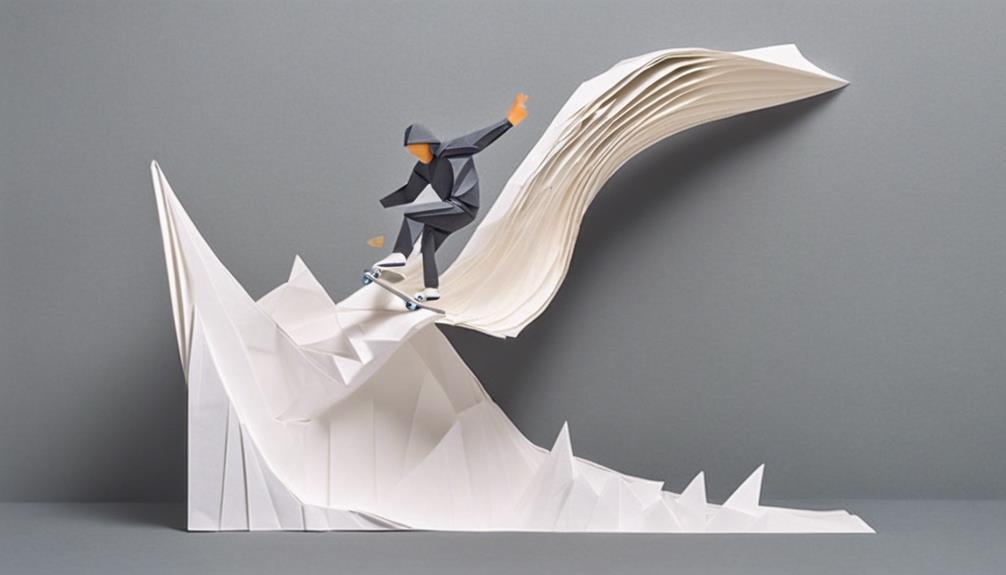
When tackling ramp riding, maintaining balance and control is paramount for a smooth and exhilarating experience. To conquer the ramps with finesse, master the drop-in technique to confidently descend into the transition. Feel the rush as you carve through the curves, executing seamless transition tricks that showcase your skill and style.
Speed management is key to owning the ramps. Learn the art of pumping, a fundamental skill that propels you up the ramp with grace and power. Harness the momentum to soar higher and faster, unlocking a world of endless possibilities in the skatepark.
Embrace the freedom that ramp riding offers. Let go of inhibitions, trust your instincts, and flow with the transitions. Feel the wind in your hair as you conquer the ramps, merging with the board to become one unstoppable force. With dedication and practice, you'll soon be tearing up the ramps with confidence and flair.
Grind and Slide Techniques
Embrace the challenge of mastering grind and slide techniques on the ramps, where precision and finesse merge to elevate your skateboarding skills to new heights. These techniques are the essence of freedom and creativity on your board. Here's how to rock those rails and slides like a pro:
- Rail Grind & Board Slide: To conquer rail grinds, approach the rail at a slight angle, pop an ollie, and land your trucks on the rail. Balance is key. For board slides, ollie onto the rail, center your weight, and let the board slide across the surface smoothly.
- Nose Slide & Tail Slide: When attempting a nose slide, pop a solid ollie and angle your board to land on the nose. Keep your weight centered to maintain balance. For tail slides, ollie onto the obstacle and shift your weight to the tail, allowing the board to slide elegantly.
Mastering these grind and slide techniques will not only enhance your skills but also liberate your creativity on the ramps. So, go out, embrace the challenge, and let the thrill of skateboarding propel you to new horizons.
Skateboard Maintenance

Proper skateboard maintenance is crucial for ensuring optimal performance and longevity of your board. Taking care of your skateboard is not just about functionality; it's an expression of your commitment to the sport. Start by regularly cleaning your board to prevent dirt buildup that can affect its performance. Use a damp cloth to wipe down the deck, trucks, and wheels. Wheel maintenance is key too; check for debris, rotate them regularly for even wear, and replace them when needed for a smoother ride.
Don't overlook the aesthetic aspect of maintenance. Your deck graphics and grip tape customization are an extension of your personality and style. Keep them fresh and reflective of your skating identity. Clean your grip tape with grip gum or a brush to maintain its stickiness for better traction.
Frequently Asked Questions
How Can I Improve My Balance and Stability While Skateboarding?
To improve your balance and stability while skateboarding, focus on balance drills and stability tips. Pay attention to your foot positioning and work on building core strength. With practice and determination, you'll enhance your skills.
Are There Any Specific Stretches or Exercises That Can Help Prevent Skateboarding Injuries?
Want to keep shredding without any gnarly injuries? Prioritize flexibility exercises like yoga or dynamic stretching to prevent wipeouts. Incorporate strength training for skateboard longevity. Your body will thank you later!
What Are Some Common Mistakes Beginners Make When Learning How to Skateboard?
When you start skateboarding, watch out for common mistakes like improper foot positioning and bad weight distribution. To improve balance, work on your core strength and ankle flexibility. Keep pushing forward!
How Can I Overcome Fear and Build Confidence When Trying New Tricks or Maneuvers?
To build confidence, you must conquer fear. Prepare mentally by visualizing success. Break down tricks into steps, practice each one. Embrace falls as part of learning. Stay determined, focus on progress, and trust your skills.
What Are Some Tips for Choosing the Right Skateboard Deck Size and Shape for My Skill Level and Style of Skating?
When choosing a skateboard deck, consider your skill level and style. Explore sizes and shapes that match your needs. Experiment with different materials for decks, weighing pros and cons. Express yourself with custom grip tape designs that reflect your style and the latest trends.

